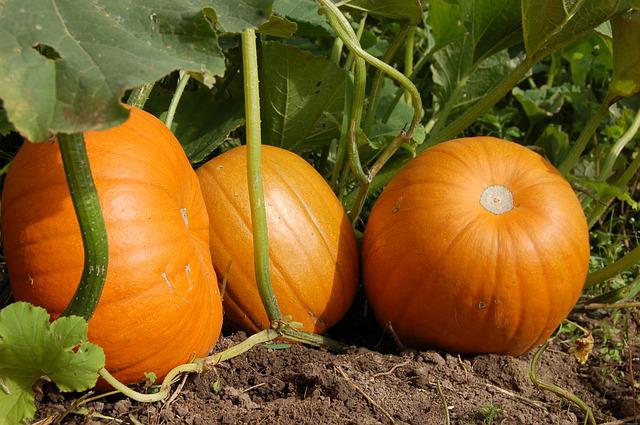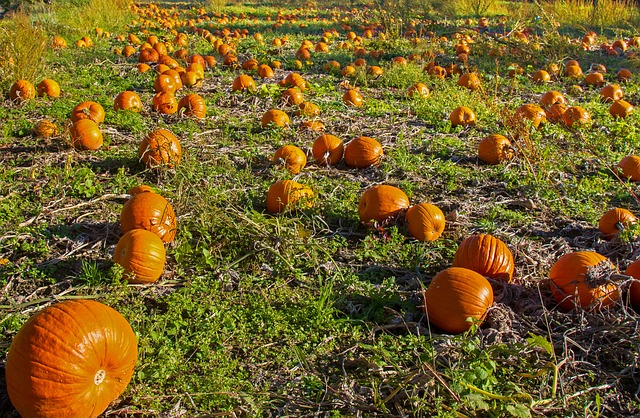How Many Pumpkins Does One Plant Produce? Guide to Growing Pumpkins

Depending on the type of pumpkin, each plant will take between 3 and 10 pumpkins on average. The bigger types of pumpkins might only give you 3–6 pumpkins, but the smaller types, like pie pumpkins, might give you 8–12. This will also depend on how well the plant is cared for during the season. All pumpkin plants grow very quickly, giving them the reputation of being an easy-to-grow fruit crop, but only so long as it is treated well.
Table of Contents
Average Pumpkin Yield According to Size
Miniature Pumpkins
Like Jack Be Little, most mini pumpkins weigh between less than half a pound and about two pounds. You can get up to 12 small pumpkins from one plant. They grow on vines that creep or climb and come in orange, yellow, and white.
Small Pumpkins
The average weight of a small pumpkin is between 3 and 5 pounds. On average, a plant will produce about 8 to 10 small pumpkins. These are often called “pie pumpkins,” and their flesh is usually sweeter and less stringy, making it suitable for cooking. Sugar Pie is a great example of a small type.
Medium Pumpkins
Medium-sized pumpkins weigh between 6 and 20 pounds, and each medium variety pumpkin plant can produce anywhere from 3 to 6 pumpkins. Lumina and Jarrahdale are two pumpkins that are about the same size.
Large Pumpkins
Most jack-o’-lanterns are made from large pumpkins, usually weighing between 15 and 30 pounds. Howden is a good example of a big pumpkin that can be carved. But the beautiful heirloom Cinderella pumpkin can also be in this size class. Large pumpkins are great for cooking and baking, as well as for Halloween. You can get anywhere from 2 to 5 big pumpkins from a single plant, with 3 being about the average successful crop.
Jumbo Pumpkins
Big Max and Atlantic Giant are two well-known jumbo varieties. If you grow a pumpkin bigger than a typical Jack-o’-lantern, you can expect to get one pumpkin per plant. This is especially true if you want to make a big one like the picture. Jumbo pumpkins are anything bigger than a large pumpkin, and their weight can vary a lot. If jumbo pumpkins grow big enough, they can weigh anywhere from 50 pounds to 2,000 pounds. According to the Canadian Broadcasting Company, the heaviest pumpkin ever was 2,624 pounds.
What Type of Pumpkin Makes the Most Pumpkins?
Smaller types of pumpkins, like the Jack B. Little, which fits in the palm of your hand, will give you the most to pick. This type of pumpkin grows on a vine and can be ready in 100 days. It can give you up to 12 pumpkins. They are easier to grow and care for, and they are thought to be very productive. The Munchkin and the We-B-Little are two other types of vines.
How To Encourage Pumpkin to Bear More Pumpkins?
- You can get two to five pumpkins from a typical variety of plants, but you can get more by doing “branching.”
- When the vines are 2 feet long, you should go to the main vine and pinch off the tips.
- Another way to get more pumpkins is to cut off the flowers with small bulbs or “swellings” at their bases. These are the female flowers, and you need to get rid of them in the first three weeks.
- You may have tried to grow pumpkins for the first time, but after the flowers grew, there were no pumpkins.
- Most of the time, pollination is the main problem. The male and female flowers on a pumpkin plant need to be pollinated by bees. If there aren’t enough bees around, you can try planting some herbs and plants that bees like.
- When a plant is just starting to grow, it needs fertilizer high in nitrogen. You should fertilize the plants when they are a foot tall and right before the vines start to spread and grow. Just before the pumpkin flowers open, switch to a phosphorus-rich fertilizer.

Is It Simple To Grow Pumpkins?
When it comes to growing pumpkins, there is no one-size-fits-all answer. This crop can be tricky to grow if you don’t understand the basics of seed propagation, so it’s important to do your research before starting. When selecting pumpkin seeds, make sure that they are good quality and have a high germination rate. Be patient once you’ve planted the seeds – pumpkin cultivation takes time! Soaking the seeds in water overnight will help increase their chances of germination.
When to Plant Pumpkins
Between April and June, pumpkins can be sown. Your pumpkin plant will be able to grow and produce pumpkins in this amount of time, and the pumpkins will also have time to ripen. Depending on the variety, pumpkins can take anywhere from 80 to 105 days to mature.
How To Plant Pumpkins for More Pumpkins
Planting Conditions
- Pumpkins should be grown in soils that let water through easily and hold a lot of water.
- If pumpkins are going to be grown in sandy soil, they need to be able to get water so that the plants grow well and the fruits develop evenly. The soil pH should be between 5.8 and 6.6, and it shouldn’t be packed down too much.
- Pumpkins are very sensitive to temperatures below 50°F, and even a light frost can hurt plants and fruit. During the growing season, the best average temperatures for pumpkins are between 65°F and 95°F. Temperatures above 95°F or below 50°F slow the crop’s growth and maturity.
- During the growing season, pumpkins need a steady supply of available water.
- Stress or a lack of water, especially during the flowering and fruit-setting times, can cause flowers and fruits to fall off. This can lead to a lower harvest.
- If you’re growing in pots or raised beds, choose compact varieties like Baby Bear that do well even when they don’t have a lot of room. The pumpkin will be smaller, but it will be easier to handle.
- If you want to grow pumpkins in the ground, choose larger varieties like Big Max, which make pumpkins that need more room and time to start producing fruit.
Spacing
- For best results, large and giant pumpkins require at least 70 square feet of space per plant. Pumpkins can grow to hundreds of kilograms when harvested if they have a lot of room to grow. Growers should space Howden and Jack-O-Lantern for a better harvest, two- to three-foot-tall pumpkin varieties, five feet apart.
- Sow spacing should be six to ten feet apart when planting small miniature pumpkins.
- Plant three to five pumpkin seeds on each hill. The space between each hill should be between four and six feet. Most gardeners are known to work this way. But row cropping the pumpkins is a better way to get them to grow faster. For pumpkins of normal size, there should be at least 12 inches of space between the rows. Pumpkins need to be five inches apart.
- This is important because pumpkins have much bigger vines that grow quickly and get big to compete with each other. If they get too close, the vines will choke each other if they have to. Row spacing and cropping are great ways to use a vine’s natural defense system to help it grow better and produce more.
Why Row Spacing Is Important
Row spacing is an essential factor that will affect how well your pumpkin harvest turns out. Many gardeners think that evenly spaced plants are the key to getting a good harvest, but this isn’t always true. Even if the plants are close to each other, they need a lot of space to grow.
No one formula can tell you that your pumpkins will grow. Gardening is a very personal hobby, and you have to try a lot of different things before you get the right harvest. The key is to learn from mistakes you’ve already made.
Grow Smaller Pumpkin Varieties if You Lack Sufficient Space
Vines of pumpkins can reach up to twenty feet or even higher. Choose a location where plants will have ample room to expand. While the vines are still young, you can direct their growth in the direction you desire. You should leave the vines to grow your pumpkin as soon as they begin to flower.
Baby Boo and Bumpkin pumpkins are great options if your garden doesn’t have room for a full-sized pumpkin. Even though some of the smaller varieties aren’t fit for human consumption, they’re a sight to behold when they reach their full size.
Planting Pumpkin Seeds
- Pumpkin seeds need to be planted between 8 and 12 inches deep in loose soil.
- Plant them with the pointed end down to don’t tip over.
- Ensure the soil is evenly moist before planting, then water them regularly until germination occurs. This can take up to two weeks, so keep an eye on your pumpkin seeds!
- Once they start sprouting, thin out the plants by hand to about 2 or 3 per pot.
- Water sparingly when doing this as you do not want too much water runoff into surrounding areas.
- At this point, it’s important to protect your pumpkin seedlings from pests and diseases by covering them with a layer of hemp or cotton fabric during warm weather and removing it during colder months when protection is no longer necessary.
- As long as you diligently water and monitor your plants, they should reach maturity within 60-90 days after being planted!

When Do Pumpkin Plants Start Bearing Fruit?
Typically, a pumpkin plant will bear fruit between September and October in the fall. When pumpkins are grown from seeds, it takes 90 to 120 days for the fruit to mature. Pumpkins are annual, which means that after producing fruit for the season, they perish and die.
Depending on the variety of pumpkin plants you select, it may take longer for your plant to produce its first fruit. Other factors, including improper pruning, overfertilization, and environmental conditions, can delay the development of pumpkin fruit on your plant.
